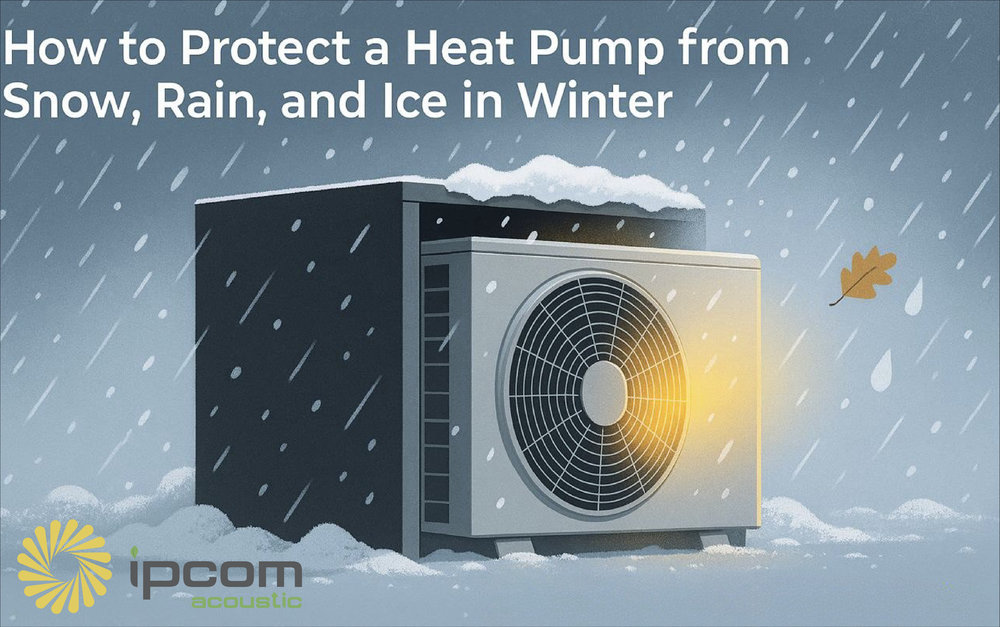With winter approaching, many homeowners ask how to protect a heat pump from snow, ice, and freezing rain.
Most modern air-to-air and air-to-water heat pump systems, such as those by Mitsubishi Heavy Industries, Daikin, or Panasonic, include a defrost mode. It is designed to melt ice on the heat exchanger, helping the unit maintain performance in freezing conditions.
Still, while defrost helps against internal frost, it doesn’t stop snow or ice from building up outside the unit. That’s exactly where most problems begin.
In this article, you’ll discover why defrost alone may not be sufficient — and which engineered solution can reliably protect a heat pump from ice and snow.
Operating Heat Pumps in Cold Weather: Defrost Mode
The defrost heat pump in winter process occurs through an automatic cycle built into most modern systems.
When frost forms on the outdoor coil, the unit switches to de-icing mode.
How the Defrost Cycle Works?
- When outdoor temperatures drop below zero, a thin layer of frost begins to form on the heat pump’s external coil.
- Modern systems automatically recognize this and activate a short defrost cycle.
- During this process, the unit temporarily changes the direction of refrigerant circulation — warm gas is redirected to the outdoor section.
- The coil gently heats up, melting the frost layer and allowing normal airflow to resume.
- As soon as sensors confirm that the coil is clear, the system returns to heating mode, once again transferring warmth indoors.
Limitations of Defrost Function:
- Temporary loss of heating: In about 90% of existing outdoor units, defrost mode stops indoor heating for several minutes.
- Sensor and refrigerant issues: Defrost may fail to start if frost detection sensors are damaged or if the refrigerant level is too low.
- No external protection: The defrost function works only inside the coil.
So how can you reduce the frequency and intensity of frost buildup — and at the same time prevent leaves, rodents, and snow from getting inside your heat pump?
The Right Way to Protect a Heat Pump in Winter
Protecting a heat pump from snow and freezing rain requires more than just defrost mode.
Engineers looked for a solution to safeguard the outdoor unit’s ventilation openings, extend its service life, and simultaneously lower noise during operation.
That’s how the acoustic enclosure was created.
An acoustic enclosure is a precision-built steel casing that forms a stable protective space around the outdoor unit.
It blocks rain, leaves, and small animals from reaching the heat pump, keeping it quiet and efficient in any weather.
Should a Heat Pump Be Covered in Winter?
No — not with a solid or fabric cover. A heat pump needs free air circulation to defrost properly and to prevent overheating.
However, using an engineered acoustic enclosure is a different case. A properly designed enclosure allows unrestricted airflow through side or rear ventilation panels.
Therefore, if you’re wondering “how to protect a heat pump in winter”, the answer is clear — with an acoustic enclosure that is soundproof, vandal-resistant, and weatherproof.
Where to Buy an Acoustic Enclosure for a Heat Pump?
You can purchase a ready-made acoustic enclosure from the manufacturer IPCOM-Acoustic, or order a custom-built model.
Each enclosure is designed for year-round outdoor use and guarantees protection against rain, snow, and debris.
With IPCOM-Acoustic housings, your climate control system will not only remain safeguarded from harsh weather but also operate 12–18 dB quieter, depending on the model.
If you still have questions about operating heat pumps in cold weather or about the design of protective enclosures, feel free to request a free consultation from the manufacturer — IPCOM-Acoustic.

